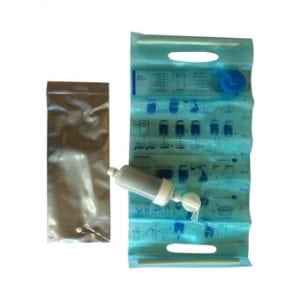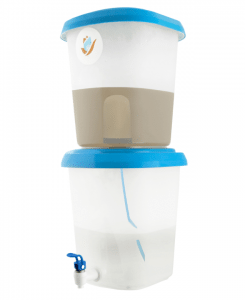
Agriculture
December 29, 2023
LifeStraw Family 2.0
Read SolutionImplemented by
LifeStraw

Updated on December 29, 2023
·Created on June 3, 2014
A family-sized household water filtration unit.
LifeStraw® Family 1.0 is a high-volume, point-of-use water purifier for use in homes without access to clean water from municipal sources. It helps prevent often deadly waterborne diseases for families in developing countries and is effective in emergency settings following natural disasters which can contaminate water.
Target SDGs
SDG 6: Clean Water and Sanitation
SDG 3: Good Health and Well-Being
Market Suggested Retail Price
$74.94
Target Users (Target Impact Group)
Household
Distributors / Implementing Organizations
Vestergaard-Frandsen with partners such as The Carter Center, Malaria no More, Roll Back malaria, United Nations Foundation and World Vision. The LifeStraw Family 1.0 filter can also be purchased under the name "LifeStraw Family" from LifeStraw, Amazon, and other distributors.
Competitive Landscape
Direct competitors include Colempaques ceramic candle filter, LifeSaver Cube, VF 100 Village Bucket Filter, WateROAM ROAMfilter Plus, LifeWell Water Filter, ACI Household Filter, LifeSaver® Jerrycan 20000UF, WateROAM ROAMfilter Lite, AquaFilter Family, TATA Swach Cristella Plus Water Purifier, LifeStraw Family 2.0, and EAWAG System.
Regions
Worldwide
Manufacturing/Building Method
Mass produced.Interview with representative
Intellectural Property Type
Patent
User Provision Model
Users can get the product via distributors during community distribution roll outs in targeted areas. Interview with representative
Product is also available for purchase online from Amazon, Lifestraw, and Walmart.
Distributions to Date Status
In 2011, 877,500 LifeStraw Family 1.0 water filters were distributed in Kenya to provide sustainable access to safe drinking water for 4.5 million people. Other filters have been sold or distributed through partnering NGOs and retailers, as well as purchased directly from LifeStraw.
Target use case
Family use
Manufacturer-specified flow rate (L/hr)
8.8 L/hr
Bacteria reduction
> 6 log
Type of membrane filtration
Ultrafiltration
Virus reduction
> 5 log
Protozoa reduction
> 4 log
Heavy metals and/or arsenic reduction
Unknown
Maximum recommended influent turbidity level (NTU)
Unknown
Effluent turbidity levels (NTU)
< 0.5
Material of construction
Plastics, rubber and ultra-fine mesh textile filters that are US Food and Drug Administration compliant or equivalent.
Safe water storage capacity (L)
None
Manufacturer-specified lifetime volume (L)
18,000 L
Design Specifications
The LifeStraw Family 1.0 filter is the same as all LifeStraw filters, which achieves ultrafiltration via hollow fiber technology whereby water is forced through narrow fibers under high pressure.
When untreated water is poured into the feed water bucket, the textile prefilter removes coarse particles larger than 80µm. Gravity pushes the water with particles finer than 80µm to flow down the plastic hose towards the purification cartridge. The purification cartridge, which contains a hollow-fiber membrane of 20nm porosity, stops all particles larger than 20nm and bacteria, protozoa, and other contaminants are trapped inside the hollow fibers and are flushed out by backwashing.
Technical Support
For the pilot project in Kenya, LifeStraw Family units are monitored by trained community representatives employed by Vestergaard. LifeStraw users must be trained on the operation and maintenance of the units. Representatives conduct visits to homes to analyze and report on units that are not operating normally. Interview with representative
Customer support offices are available to help all LifeStraw filter users.
Replacement Components
For the pilot project in Kenya, replacement systems are available if community representatives determine that the unit is faulty. All units are tracked via QR codes by representatives. The LifeStraw Family 1.0 filter is designed not to need replacement components. Interview with representative
Lifecycle
Guaranteed up to 18,000 Liters (4,750 Gallons). According to Vestergaard, enough to supply clean drinking water for a family of five for up to 3 years.
Manufacturer Specified Performance Parameters
Manufacturer specifies the following: removes minimum 99.9999% of bacteria (>Log 6 reduction), 99.99% of viruses (>Log 4 reduction) and 99.9% of protozoan cysts (>Log 3 reduction), removes turbidity, does not require electrical power, does not require batteries, does not require replacement parts, does not require running water, does not require piped-in water supply, has an easy-to-clean pre filter, has an easy-to-clean purification cartridge, and all raw materials are US Food and Drug Administration compliant or equivalent.
Vetted Performance Status
A number of laboratory studies and health impact and field studies have been carried out:A laboratory assessment of a gravity-fed ultrafiltration water treatment device designed for household use in low-income settings was funded by Vestergaard Fransen, and ran by London School of Hygiene and Tropical Medicine, and University of Arizona. It is the independent laboratory that tested and produced these results via EPA Protocol and Guide Standard for Testing Microbiological Water Purifiers. It is part of LifeStraw Family Evidence Dossier (available by request)LifeStraw® Family Quality Inspection is completed by Intertek in Vietnam."Assessment of the LifeStraw Family Unit using the World Health Organization Guidelines for "Evaluating Household Water Treatment Options: Health-based Targets and Performance Specifications", 2011. by the University of Arizona Department of Soil, Water and Environmental Science. Authors: Jaime Naranjo, B. S. and Charles P. Gerba, Ph.D.Rotavirus Reduction by LifeStraw Family 1.0 Filters, 2013 by the University of Arizona Department of Soil, Water and Environmental Science. Authors: Jaime Naranjo, B. S. and Charles P. Gerba, Ph.D.Confirmation of 20 nanometer pore size by Para Membranes Co. Ltd, Korea
Safety
Contamination of filtered water is possible with exposed/improper handling and storage.
Complementary Technical Systems
A container is needed to collect the filtered water.
Academic Research and References
Perron, S., 2012, “Microbial Regrowth in Drinking Water Treated with Gravity-Driven Ultrafiltration A Field Study in Kenya,” M.S. thesis, Department of Earth Sciences, Air, Water and Landscape Science, Uppsala University Villavägen.
Clasen, T., Naranjo, J., Frauchiger, D., Gerba, C., 2009, “Laboratory assessment of a gravity-fed ultrafiltration water treatment device designed for household use in low-income settings,” Am J Trop Med Hyg, 80(5), pp. 819-23.
Pérez-Vidal, A., Díaz-Gómez, J., Salamanca-Rojas, K. L., y Rojas Torres, L. Y., 2016, “Evaluation of drinking-water treatment by Lifestraw® and Ceramic-pot filters,” Revista de Salud Pública, 18(2), pp. 275–289.
Elsanousi, S., Abdelrahman, S., Elshiekh, I., Elhadi, M., Mohamadani, A., Habour, A., ElAmin, S., ElNoury, A., Ahmed, E., and Hunter, P. R., 2009, “A study of the use and impacts of LifeStraw™ in a settlement camp in southern Gezira, Sudan,” Journal of Water and Health, 7(3), pp. 478–483.
Redfield, P., 2015, “Fluid technologies: The Bush Pump, the LifeStraw® and microworlds of humanitarian design,” Social Studies of Science, 46(2), pp. 159–183.
T. Clasen, J. Naranjo, D. Frauchiger, and C. Gerba, “Laboratory assessment of a gravity-fed ultrafiltration water treatment device designed for household use in low-income settings,” Am. J. Trop. Med. Hyg., vol. 80, no. 5, pp. 819–823, 2009.
“LifeStraw Family,” LifeStraw Water Filters & Purifiers. Available: https://lifestraw.com/products/lifestraw-family-emergency-water-filter
Vestergaard, “Homepage,” Vestergaard, 03-Dec-2020. Available: https://vestergaard.com/
“The Carter Center,” The Carter Center. Available: https://www.cartercenter.org/
“Home,” Malaria No More. Available: https://www.malarianomore.org/
“Log in,” Endmalaria.org. Available: https://endmalaria.org/about-us/overview
“About World Vision,” Wvi.org. Available: https://www.wvi.org/
LifeStraw Family 1.0 Portable Gravity Powered Water Purifier for Emergency Preparedness and Camping. Available: https://www.amazon.com/LifeStraw-Portable-Purifier-Emergency-Preparedness/dp/B00FM9OBQS?th=1
“ZeeWeed Hollow-Fiber Membranes,” Watertechnologies.com. Available: https://www.watertechnologies.com/products/zeeweed-ultrafiltration
“Competition,” Tata Swach Water Purifier. Available: https://tataswach.com/
“ceramic and candle Filters – Pureit Water India,” Pureitwater.com. Available: https://www.pureitwater.com/
P. By, “General assembly event sustainability report Kansas City, Missouri 2018,” Uua.org. Available: https://www.uua.org/files/pdf/u/uua-ga-2018-sustainability-report.pdf
Pritpalkalsi, “e Brochure Lifestraw and Lifestraw Family English,” dokumen.tips. Available: https://dokumen.tips/documents/e-brochure-lifestraw-and-lifestraw-family-english.html?page=3
Office of the Commissioner, “U.S. Food and Drug Administration,” U.S. Food and Drug Administration, 16-Oct-2023. Available: https://www.fda.gov/home
Chemical disinfection, “Of the WHO international scheme to evaluate household water treatment technologies,” Who.int. Available: https://iris.who.int/bitstream/handle/10665/204284/9789241509947_eng.pdf?sequence=1
“Crowdrise +,” GoFundMe, 18-Feb-2022. Available: https://www.gofundme.com/c/crowdrise
Compliance with regulations
Complies with the US Environmental Protection Agency (EPA) 1987 Guide Standard and Protocol for Testing Microbiological Water Purifiers , US Food and Drug Administration, and meets the criteria of the “Highly Protective” category for microbiological performance specifications as defined in WHO’s 2011 ‘"Evaluating Household Water Treatment Options: Health-based targets and microbiological performance options."
Evaluation methods
The product has been evaluated for microbiological and turbidity removal, proper function, and membrane pore size by third-party laboratories. Health impact and field studies have also been performed.
Other Information

Agriculture
December 29, 2023
Implemented by
LifeStraw

Agriculture
December 29, 2023
Implemented by
Vestergaard

Agriculture
December 27, 2023
Implemented by
Aquabox, UK

Agriculture
October 19, 2023
Implemented by
Grifaid

Agriculture
March 7, 2024

Agriculture
February 19, 2024
Implemented by
Earthquake Engineering Research Institute (EERI)
Agriculture
March 11, 2024

Agriculture
December 29, 2023
Implemented by
RealRelief

Agriculture
January 4, 2024
Implemented by
Basic Water Needs

Agriculture
January 2, 2024
Implemented by
wateroam
Have thoughts on how we can improve?
Give Us Feedback